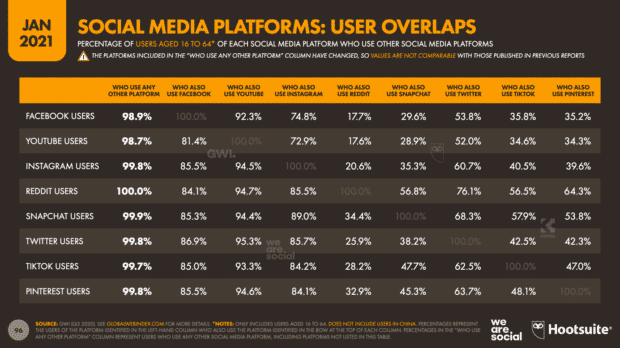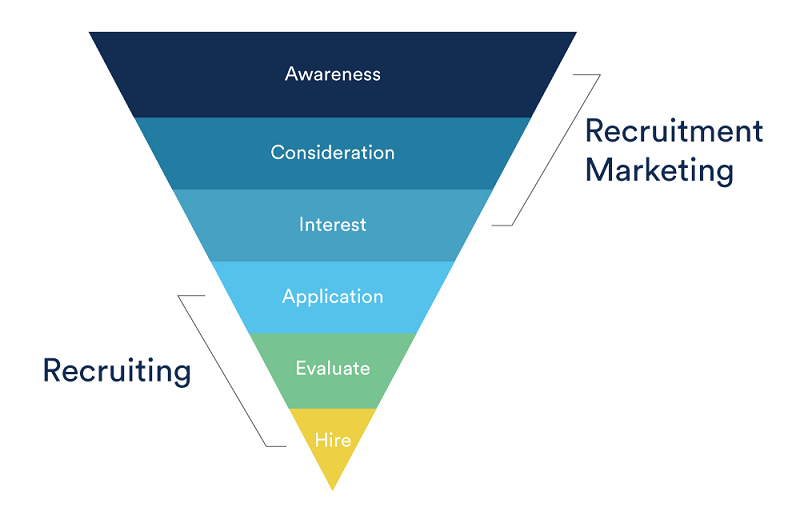Recruitment marketing automation allows you to automate and streamline repetitive tasks in the recruitment process. Effective recruitment marketing automation will help your HR team save time by taking time-consuming tasks off of their hands.
Saving time on repetitive tasks will free up personnel to do other activities. For example, promote job openings through other marketing channels. Or, maybe they’ll use that time for a completely different set of activities.
In the recruitment funnel, recruitment marketing activities would cover the first three stages: awareness, consideration, and interest.

Source: PageUp People
Let’s look at these stages one-by-one:
- Awareness: Build awareness of a job opening or the company.
- Consideration: Get talent to think of you as a potential employer.
- Interest: Get potential candidates to apply for the job vacancy.
A lot of recruitment marketing activities revolve around sharing job listings across social networking sites. They also include posting job advertisements on boards and creating content to attract your ideal candidates.
Automation of these recruitment marketing activities enables you to optimize your recruitment marketing efforts. Furthermore, it gives you time to focus on other things such as employer brand-building and communication with candidates. That means your company can attract and recruit better talent.
Now that you know the importance of recruitment marketing automation. I’ll cover five steps you can take to automate your recruitment marketing.
1. Automate Applicant Screening
Automating the applicant screening process isn’t really within the purview of recruitment marketing. In the recruitment funnel, it would be part of the recruitment process. However, there are many tools for automating your applicant screening that allow you to automate your recruitment marketing activities.
There are recruitment marketing automation tools that can help you advertise job openings across multiple marketing channels. These include popular job boards and job websites like SimplyHired, GlassDoor, ApplyIQ, Recruit.net, amongst others.
When you automate your applicant screening, you enhance your recruitment marketing, in general. Thanks to Applicant Tracking Systems (ATS), applicants don’t need to wait for too long for a response from you. In short, you give them that great candidate experience. That, in turn, enhances your employer image, which makes it easier for you to, again, promote your brand to potential candidates when another job vacancy arises.
2. Engage Across Multiple Channels
Engagement is key to your recruitment marketing success. When you engage potential candidates even when there’s no job vacancy available, you drum up interest in your employer brand and attract great talent.
To engage potential candidates, you need to create suitable recruitment content. That content needs to be professionally edited. It’s important to use a suitable grammar checker to review your content. You then need to promote that content across multiple channels.
The following make for great recruitment content:
- Infographics: Share a little bit about your company through engaging and organized visuals.
- Quizzes: For example, post five questions that will determine whether or not a person is a good fit for your company.
- Video: Why not post a video about your employer brand? You can showcase your employees and your company culture, too. Or give them an office tour.
- Blog posts: You can discuss employee initiatives, important events, and company milestones. The good thing about blog posts is they can boost your SEO, too!
- Other visuals: For example, you can compile multiple images and create a slideshow.
Now, where exactly should you post that recruitment content?
Answer? When promoting your employer brand, you need to adopt an omnichannel approach. That’s because people, including potential candidates, do not limit themselves to a single platform online.
According to Hootsuite, at least 98% of users of any given social media platform also use at least one other social media platform. There are significant audience overlaps, too, across platforms.

Source: Hootsuite
Also, there are other channels where specific professionals “hang out.” For instance, if you want to hire PHP developers, you’d look for them on Stack Overflow and Reddit platforms. Both these platforms have strong communities of technology-savvy potential candidates.
In other words, you need to post interesting content about your company across all those platforms (for social media, LinkedIn is a good one).
Thanks to recruitment marketing automation, you can run recruitment campaigns across multiple platforms. Social media management tools can also help you schedule the publication of content on social media.
With automation, you don’t need to spend too much time manually completing relevant recruitment marketing tasks. You can spend your time focusing on other aspects of the recruitment process.
3. Nurture Relationships with Prospects
Don’t just engage people you haven’t interacted with. Engage with those who have already expressed an interest in your company, too. You need to do this even when you’re not actively recruiting. You want to ensure you have a talent pool, so when a job vacancy does become available, it’s easy to find qualified candidates.
You can create that talent pool by nurturing relationships with prospects. You can do this across various channels.
Statistics show that nurturing prospects does work. According to Recruiting Daily, 81% look favorably at companies that continuously communicate with them. That means when the time comes, they need to choose an employer. Once they do submit their applications, you’d be at the top of their list.
Before we get into how you can nurture prospects, let’s talk about who these prospects are in the first place.
These can be people who expressed an interest in the company by subscribing to your talent pool. They can be former applicants who never got the job. They can even be your former employees.
Now let’s talk about how to nurture them. Here are two common ways:
- Run a nurturing campaign: Send an email sequence to those who subscribed to your talent pool on your website. For example, the first email can be a welcome email, the second a get-to-know your company email, and the third, an event invite. The event should be specific to your target group. So if you’re targeting tech graduates, the event could be a hackathon. The next email could be your next job advertisement.
- Keep in touch with former employees and applicants: Never burn bridges. If an applicant doesn’t make it to the next stage of the hiring process, it doesn’t mean they can no longer be your employee. They might just be a good fit for other positions. Or if the same position opens, you can ask them to apply again. Your former employee is also a good potential candidate (unless they were fired). That’s because former employees already know how it is to work in the company.
Thanks to available tools such as Herefish, all these strategies can (and should) be automated.
That email sequence can be triggered automatically as soon as prospects join your talent pool. You wouldn’t have to create an email for each prospect. You can also automatically send relevant company content to your former employees and applicants and send automated follow-ups.
4. Run Direct Outreach Campaign
When you do have a job opening, it’s important to advertise the position widely. As I mentioned previously, publishing openings through social media, job boards, and other channels is one effective way of getting good candidates to apply for your position.
In addition to general marketing campaigns, it’s important to consider direct outreach and referral marketing. Direct outreach involves messaging candidates you believe would be suitable based on their work experience to see if they are interested in applying for the position. You’ll need to use a suitable email ID finder to collect their details.
Referral marketing involves asking for a recommendation for a suitable client from people in your industry.
There are ways you can automate some of these processes if you choose to automate your recruiting efforts. For example, there are tools for LinkedIn that allow you to create lists of people based on personal and business connections based on their position at a company. You can then send personalized messages to your list, either asking if they would be interested in the position you are looking to fill or if they can recommend a suitable candidate.
Direct outreach can be a direct way to find suitable candidates for a position. However, you don’t need to go as far as outreach. Simply being able to create a list of people from within your industry with the relevant experience can be a good starting point for a targeted recruitment drive.
5. Segment Your Potential Candidates
In traditional marketing, audience segmentation is critical to run personalized campaigns. The same is true in recruitment marketing.
If you want to craft more personalized messages that will get a potential candidate to take your desired action (in this case, apply for a job vacancy), you need to segment your potential candidates, too. Segmenting them can help you create more targeted messages because it helps you do three things: understand your potential candidates better, see who is receiving the appropriate content, and identify content gaps.
You can also identify the appropriate channels to reach them.
For instance, once you find out, based on your segmentation, that X wants a career in marketing, you’d stop sending them emails about HR software in a nurturing campaign. You’d send emails about other topics instead.
You can segment your audience in many ways. For example:
- Demographic: Age, gender, occupation, family size
- Behavioral: Website usage, loyalty
- Psychographic: Social class, lifestyle
- Geographical: Country, city, among others
The way you segment your potential candidates depends on you.
Now, the next question is, how do you segment your audience?
You can do that manually, but that would be very time-consuming. It can take hours, even days, before you have your complete list of potential candidates classified according to specific factors. That would be time better spent on other things to improve your recruitment process.
Summing Up
If you want to get the best talent for your company, you need to know how to market your employer brand. Recruitment marketing is critical to the success of your recruitment strategy. If people perceive you as a great employer, they won’t hesitate to apply for your company’s job. If they perceive you as an employer who doesn’t care, they won’t even consider working with you.
But the recruitment marketing process entails undertaking a series of activities that can be repetitive and time-consuming. The bad news is, you can’t do away with those activities because they are key to the success of your recruitment marketing efforts. How do you ensure your recruitment marketing success without spending too much time on those necessary tasks?
The answer? Automate.
Through technology, you can streamline your recruitment marketing process, so no effort goes to waste. You save plenty of time, which you can devote to other aspects of your recruitment process. As a result, you improve your recruitment process, too.
In other words, thanks to recruitment marketing automation, things–at least on the marketing side–will be easier for you. You’ll reap benefits, too. All that great talent will just be raring to work with you.
Looking For HR Management System?
Call Pursho @ 0731-6725516
Telegram Group One Must Follow :
For Startups: https://t.me/daily_business_reads




